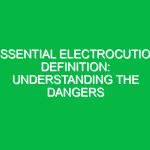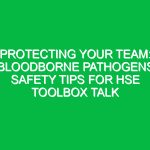Introduction
Personal Protective Equipment (PPE) is a critical aspect of health, safety, and environmental (HSE) practices across various industries. The PPE definition refers to any clothing, equipment, or device designed to protect the wearer from potential hazards that can cause injury or illness. This definition extends beyond mere physical barriers; it encompasses a comprehensive approach to safeguarding individuals working in environments where risks are prevalent. Understanding the significance of PPE within the HSE framework is vital for maintaining a safe workplace and ensuring the well-being of employees and the surrounding community.
In this article, we will delve deep into the PPE definition, exploring its relevance, key components, associated risks, and best practices. Additionally, we will examine the regulations and standards governing PPE usage, providing insights that can help organizations implement effective safety measures.
The Core of PPE Definition in HSE
At its essence, the PPE definition in the HSE context focuses on the protective gear used by workers to mitigate exposure to various hazards. These hazards can range from chemical spills and airborne contaminants to physical dangers like falling objects or extreme temperatures. PPE includes a wide variety of equipment, such as helmets, gloves, eye protection, respiratory devices, and hearing protection.
Understanding the components of PPE is crucial for organizations aiming to create a safe working environment. Each piece of equipment serves a distinct purpose, tailored to specific risks encountered in various industries. For instance, construction workers typically wear hard hats to shield against head injuries, while healthcare professionals don scrubs and masks to prevent the transmission of infectious diseases.
Key Aspects of PPE in Health, Safety, and Environment
Types of PPE
The types of PPE can be categorized based on the specific hazards they address:
- Head Protection: Hard hats protect against head injuries from falling objects or bumps.
- Eye and Face Protection: Safety glasses and face shields guard against flying debris and chemical splashes.
- Hearing Protection: Earplugs and earmuffs reduce noise exposure in loud environments.
- Respiratory Protection: Masks and respirators filter harmful airborne substances.
- Hand Protection: Gloves protect against chemicals, cuts, and abrasions.
- Foot Protection: Steel-toed boots prevent injuries from heavy objects and slips.
- Body Protection: Protective suits and aprons shield against chemicals, heat, and spills.
Each type of PPE is designed to address specific risks, and the correct selection is paramount for effectiveness.
Identifying Hazards
A crucial step in implementing PPE is hazard identification. This involves assessing the workplace for potential risks that employees may encounter. For example, in a manufacturing facility, workers may be exposed to various chemicals, moving machinery, and loud noise levels. Conducting a thorough risk assessment allows organizations to determine the appropriate PPE required for different tasks.
Real-life scenarios highlight the importance of proper PPE usage. In a case study involving a chemical plant, workers who failed to wear adequate respiratory protection were exposed to harmful vapors, leading to respiratory issues. This incident underscored the necessity of effective PPE protocols and proper training for employees.
Best Practices for PPE Usage
To maximize safety, organizations must adopt several best practices concerning PPE usage:
- Conduct Training: Regular training sessions ensure that employees understand the importance of PPE, how to use it correctly, and the specific hazards they may face.
- Regular Inspections: Routine checks of PPE equipment help identify wear and tear, ensuring that gear is in optimal condition.
- Encourage Reporting: Employees should feel empowered to report any issues with their PPE or potential hazards without fear of reprisal.
- Personalized Fit: Ill-fitting PPE can fail to provide adequate protection. Organizations should ensure that equipment is appropriately sized for each worker.
- Compliance with Standards: Adhering to industry standards and regulations not only safeguards employees but also minimizes legal liabilities.
These practices create a culture of safety, enhancing the effectiveness of PPE and reducing workplace injuries.
Potential Risks and Safety Considerations
Despite the protective nature of PPE, there are inherent risks associated with its use. The most significant risk arises when PPE is not utilized correctly. For instance, if a worker fails to wear a hard hat in a construction zone, they expose themselves to severe head injuries. Additionally, improper maintenance or inadequate training can lead to ineffective protection.
Moreover, workers may develop a false sense of security when wearing PPE, potentially leading to reckless behavior. It is essential to foster an understanding that while PPE is vital, it should be part of a broader safety strategy that includes engineering controls and administrative measures.
Regulations and Standards Governing PPE
Numerous regulations and standards govern the use of PPE in the workplace. In the United States, the Occupational Safety and Health Administration (OSHA) outlines specific requirements for PPE in various industries. OSHA mandates that employers assess workplace hazards and provide appropriate PPE to employees at no cost.
Internationally, the European Union has established regulations regarding PPE under the Personal Protective Equipment Regulation (EU) 2016/425. This regulation ensures that PPE is designed and manufactured to high safety standards, minimizing risks to users.
Compliance with these regulations is crucial not only for employee safety but also for legal adherence and organizational reputation. Organizations that prioritize PPE compliance demonstrate a commitment to health and safety, enhancing employee morale and public perception.
Conclusion
In conclusion, understanding the PPE definition within the context of health, safety, and environment is essential for fostering a safe workplace. From identifying hazards to selecting appropriate equipment and adhering to regulations, each aspect of PPE plays a vital role in protecting employees from risks.
The importance of proper PPE usage cannot be overstated; it is a fundamental component of workplace safety that contributes to overall health and environmental sustainability. Organizations must prioritize training, compliance, and best practices to ensure that PPE is not just a regulatory checkbox but a genuine commitment to the safety and well-being of all employees.
As we move forward, it is imperative to continue advocating for safety measures and creating environments where workers can perform their duties without fear of injury. By embracing the full scope of PPE and its significance in HSE, we can unlock a safer future for everyone.


